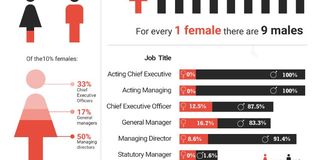Only 8pc of TZ CEOs are female

What you need to know:
Does lack of diversity and inclusion in Tanzania’s board rooms mean regulations are not clear or aggressive enough?
Dar es Salaam. Tanzania has made progress in reversing some of its customs and traditions which contribute to greater gender inequality but the facts show that gender parity in the corporate world still remains a dream.
A survey by The Citizen shows that only 12 out of 140 large private companies and non-government organizations that were surveyed last year are headed by women Chief Executive Officers (CEOs) and directors.
The survey conducted for the annual year 2016 mentions the CEOs in question (with the name of the company in brackets as) as Violet Mordichai (AAR Insurance Company Limited), Ms Jacqueline Woiso (Bank M Tanzania PLC), Ellen Mkondya Senkoro (Benjamin William Mkapa Foundation) and Alice Indodi (EXP Tanzania). Others are Zuhura Muro (Kazi Services Ltd), Helene Weesie (Serengeti Breweries Ltd), Amne Suedi (Shikana Law Group) Margaret Nnko (Strathmore Business School) and Prema Lalji (The Rickshaw Travel Group), Furthermore data from the Bank of Tanzania indicate that only 12 per cent of CEO positions in the banking sector are currently held by women in the country and that only 8 per cent of managing director positions in the banking sector are held by women.
But gender diversity in the rest of the globe is actually on the rise. By 2016 nearly 19% of CEO positions in the world’s largest companies were headed by women. The slow but steady increase in gender equality in the global private sector is owed to rigorous regulations by governments around the world. Does the lack of diversity and inclusion in Tanzania’s board rooms mean that Tanzania’s regulations are not clear or aggressive enough?
In 2008 Tanzania ratified article 12 of the SADC protocol article 12 of the Sadc protocol on gender and development (2008) which requires members to ensure 2015, at least 50 percent of decision making positions in the public and private sectors are held by women by using affirmative action as provided for in articles 5. Unfortunately, Tanzania has failed to meet this target. CEO Roundtable of Tanzania chairman Ali Mufuruki says that more collective effort from the private and public sectors is needed to be able to bridge the gap especially as traditions, religion and customs still contribute to the unequal gender roles. “Gender parity is a big topic but the reality does not show this,” he said. He notes that the country needs more aggressive reforms to ensure women are accorded the same status as men. But even with some regulation in place, what other factors prevent Tanzanian women from taking up more leadership roles? Tanzania Private Sector Foundation (TPSF) executive director, Godfrey Simbeye says while the country accords equal opportunities for lower and tertiary education for both genders, the reverse is seen in the corporate world leadership. “I don’t understand the reason for this. Few women hold CEO positions despite having had equal resources when in school. Could it be that they are not aggressive enough to grab the opportunities? Company owners only look for someone who can bring them profit and gender does not take precedence they want aggressive individuals,” he says.
The World Economic Forum (WEF) Global Gap Report 2017 Global Gap Report 2017 reveals that with the current trend, on the overall global gender gap can be closed in exactly 100 years across the 106 countries covered since the inception of the Report, compared to 83 years last year. The report’s Gender Gap Index ranks countries according to calculated gender gap between women and men in four key areas: health, education, economy and politics to gauge the state of gender equality in a country. The most challenging gender gaps remain in the economic and health spheres. Given the continued widening of the economic gender gap, it will now not be closed for another 217 years. However, unequal access to education could be reduced to parity within the next 13 years. The political dimension currently holds the widest gender gap and is also the one exhibiting the most progress, despite a slowdown in progress this year. It could be closed within 99 years.
The health gender gap is larger than it stood in 2006.While all world regions record a narrower gender gap than they did 11 years ago, more efforts will continue to be needed to accelerate progress. At the current rate of progress, the overall global gender gap can be closed in 102 years in Sub-Saharan Africa, 157 years in the Middle East and North Africa.



